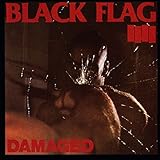I.
 In 1981, Black Flag released the album Damaged. The fifth song on that album, a cornerstone of the American hardcore movement, is “T.V. Party,” a direct critique of America’s complacent consumption of popular culture, in this case in the form of television:
In 1981, Black Flag released the album Damaged. The fifth song on that album, a cornerstone of the American hardcore movement, is “T.V. Party,” a direct critique of America’s complacent consumption of popular culture, in this case in the form of television:
We’ve got nothing better to do
Than watch TV and have a couple of brews.
Don’t wanna talk about anything else;
We don’t wanna know!
We’re dedicated to our favorite shows.
“That’s Incredible!”
“Hillstreet Blues!”
“Dallas!”
“Fridays!”
It’s no wonder that Black Flag didn’t think highly of television at the time. Cable was in its nascent period, and HBO wouldn’t begin 24-hour broadcasting until later that year. While shows like Quincy and The Jeffersons had their fans, it wasn’t exactly a golden age. In short, with nothing but network TV to choose from, nothing was on, even if one’s TV was working.
At the heart of “T.V. Party” is a straightforward dichotomy — between the mainstream and underground or indie culture. That’s Incredible for the masses, Black Flag for the discerning few. What the masses love must be intellectually easy, unchallenging and relatively uniform, while those on the fringes indulge in the risky stuff – art. This dichotomy has existed since, well, probably Marx, but it was best articulated by Theodore Adorno and other Frankfurt School philosophers in the middle of the 20th Century. It continues to the present day, relatively unchallenged. Granted, it’s taken on new targets – for some, it’s no longer TV that rots our brains, it’s the Internet – but its central argument remains basically the same. There is that which exists for the mainstream and that which is “other.”
 But is that ending? In a post on his blog referencing Kaya Oakes’ book Slanted and Enchanted: The Evolution of Indie Culture, publishing consultant and former head of Soft Skull Books Richard Nash proclaimed:
But is that ending? In a post on his blog referencing Kaya Oakes’ book Slanted and Enchanted: The Evolution of Indie Culture, publishing consultant and former head of Soft Skull Books Richard Nash proclaimed:
All is changed, changed utterly. Indie doesn’t mean anything anymore. It’s dead. Which is OK, because it won. Open source, Twitter. Indie won. Etsy. The irresistible decline of major labels and network TV and corporate publishing. Indie won.
In the comments on the post, Nash further expands on this idea:
[Y]ou can’t go mainstream any more, either. The process I described above is a process that has as its corollary the end of mainstream! …Mainstream basically depends on broadcast—that America sits down and has the same content broadcast to us, and we talk about it [the] next day around the watercooler. And that is atrophying too. We are paying less attention to what is broadcast to us, and more attention to what we go out and find ourselves, and to what a friend has told us we should go and find. Which is a principle indie relied on.
(For the record, Oakes agrees with Nash, that indie culture, as it existed up until roughly 2001 or so, is no more.) This is pivotal – that mainstream culture inherently means broadcast, while indie culture implies a sort of social connection, a give and take. I don’t wish to challenge Nash’s definitions of the two, as I think he’s on to something. Black Flag railed against the passive acceptance of a cultural product beamed to thousands as one-way communication in part, no doubt, because it stood in such contrast to what they themselves were doing at the time, recording and distributing their own music on their own record label, and developing a network of venues for touring. As Nash rightly points out, the means of production have largely been seized.
If you’d like to make an album or publish a book, there are avenues available to you that have never been open before. On the production end of things, indie culture certainly seems to be winning (and thank God for that), though holdouts remain. It’s on the receiving end that the old dichotomy continues to exist. There is still popular music – that’s to say music that charts and that sells relatively well (though not as well as it used to, for sure) – and then there is all of the other stuff. It would be hard to argue that Jay-Z, for instance, isn’t inherently “mainstream,” even if he owns the label that puts out his music. Whether it’s waning or not, there is still a vibrant mainstream culture in America, and it remains largely a one-way, broadcast culture. That’s not to say that some of the walls between the two – between what the “masses” enjoy and what the “fringe intellectual snobs” like – aren’t dissolving.
II.
Last week, Pitchfork, the paragon of independent music criticism, released its top 500 singles of the last decade. It featured the usual list of bands that would never crack the top ten on the charts in the United States – The Knife, Animal Collective, LCD Soundsystem – but a quick glance at its top twenty is telling. Among those songs deemed the best by the top critical outpost on the Internet, a site known for championing little-heard acts, there are a surprising number of “hits.” Missy Elliot, M.I.A., Beyonce (featuring Jay-Z, naturally). All were top ten hits released by major labels (and, maybe not coincidentally, made by people of color, as opposed to the rest of the list). The top spot on the list belongs to Outkast, the eclectic but now thoroughly popular hip hop act from Atlanta (released by a subsidiary of Sony Records). Don’t worry, Pitchfork is quick to point out that the song they’ve deemed the best, “B.O.B.,” was:
[T]oo disorienting and exhausting an experience to ever succumb to over-saturation, and its majesty has never been diminished by ironic cover versions from cred-hungry rock bands. Because even after a decade that’s seen the act of copying music become as easy as a mouse-click, and the process of performing simplified for toy video-game guitars, the future-shocked ferocity “B.O.B.” is something that just cannot be duplicated.
Even as it more or less argues that indie culture is deader than hair metal, Pitchfork continues to draw a dichotomy between the mainstream and a perceived underground (It’s worth noting that their write-up of the second song on their list, LCD Soundsystem’s “All My Friends,” is largely indictment of current indie malaise).
Though it may appear otherwise, I would argue that indie culture isn’t dead, it’s merely changing and divorcing itself from whence its root terminology derives, its mode of production. It isn’t dead because the mainstream still exists, though it too is changing at a ferocious pace. These changes play out most noticeably on the web, where a truly mainstream event and one that resonates with relatively few can feel like events of similar magnitude.
III.
Like most people reading this post, I spend a fair amount of my time (10 plus hours a day) on the Internet. I use it for work, I use it for play, I use it to find recipes for salads. Most of the time, it seems that the web is serving roughly the purpose that most suggest it will – it’s bringing me in touch with a diversity of news stories, opinions and creative works unlike anything I would’ve encountered before it – but every now and then, something happens and every piece of the web that I touch is about that one thing, and seemingly nothing else.
This summer’s most transcendent internet moment was the death of Michael Jackson. One could argue that this was a news event, akin to a presidential election or a war, rather than a pop culture phenomenon, but it seems to me to fit somewhere in between, and it illustrates how the various niches that make up the web — Tumblr, Twitter, my RSS feed — can still combine to force something into your consciousness. In other words, despite having this vast network of information sources available to me, for a few days, all anybody wanted to talk about was Michael Jackson. He was all over most of the blogs I read. He was on Twitter, with something like eight different trending topics related to him (RIP, MJ, Jackson, Jacko, etc.). Facebook looked like the Neverland Ranch. Even in those weird little underground caverns of the web that I like to frequent (a Red Sox fan site, for instance), there he was, moonwalking into the great beyond.
At first glance, I was tempted to say that the third season of Mad Men was a similarly popular pop culture event. The build up to the episode was intense. First there was the promotional campaign (actor Jon Hamm in a room full of water), then there were the interviews with the cast members. Before long, everyone was Mad Men-ing themselves, turning their Twitter and Facebook avatars into little animated characters in the style of the show. Indeed, this very site ran a fine essay that pointed out more or less exactly this:
It’s all around us; it’s everywhere we go; it’s everything we do. It’s Mad Men. At the coffee shop: “I’ll have a grande iced Mad Men with whole Mad Men please.” “You want that Mad Men?” “No thanks, I’ll add my own Mad Men.”
In the case of Mad Men, I was a little more than a disinterested party. I’d seen the first season of the show and liked it, but I wasn’t going to be watching the premiere. I have a TV that functions very well as a DVD monitor, but unfortunately gets no channels, and I hadn’t finished watching season two. (Leave it to The Millions to hire a pop culture columnist who doesn’t watch TV.) It’s possible I was noticing Mad Men everywhere because I wanted to, but as I think many will agree, it was hard to miss the show.
Except that most people did. Miss it, that is. Only 2.8 million people watched the season three debut. In contrast, on the same night, 8.7 million people watched a repeat of the show Two and a Half Men. The reasons for this are many, but the most obvious is that people could watch the Two and a Half Men repeat for free while only paying cable customers could watch Mad Men, which airs on cable channel AMC. But there are tens of millions of cable subscribers in America, and still only a small fraction tuned into Mad Men. It simply wasn’t the cultural event everyone made it out to be, at least not for the majority of America.
IV.
Despite the radical shifts that are happening in how we consume and discuss popular culture, there is still a real rift between what is truly popular, in terms of audience size, and what is merely in the zeitgeist of a particular segment of the population. Like tends to find like, online and off. I enjoy Mad Men more than Two and a Half Men, so it’s likely that I would follow people on Twitter and Tumblr who do as well. And this has a profoundly distorting effect on how we perceive cultural events. This phenomenon, is precisely what made the election of Barack Obama, and particularly the scale of his victory, so incredible to many of us. As C. Max Magee, the editor of this site, put it, “None of us could quite believe that the saturation and enthusiasm extended beyond our own particular (online) social network (which we feared must be far too small to win him the election).”
Indie as a term of production might be losing its relevance, but there still exists a real counterculture, or at the very least, a shadow culture, in America. It exists because there persists in being a mainstream to position itself against. Mad Men markets and presents itself as television for the discerning viewer. It’s exactly what was missing during Black Flag’s heyday (It’s hard to imagine them making the song with The Wire! thrown into a chorus). It’s the latest in a line of such shows, almost always on cable (often on premium cable), that garner critical praise and inspire internet memes by the dozen, but don’t nearly that big a dent in the consciousness of the average American.
Maybe the lesson here is that, as the distinction between mainstream and indie ceases to be relevant from a production standpoint, it should cease as well to be a way of categorizing art. The great thing about Pitchfork’s list is that it embraces the elements of both the mainstream and the underground equally. The only deciding factor is quality. Maybe rather than asking “Is this indie?” we should satisfy ourselves with asking “Is it a good show?” or even better, “Do I like it?” Now if you’ll excuse me, I’m off to write the pilot for my new mainstream/indie hybrid hit Two and a Half Mad Men.








